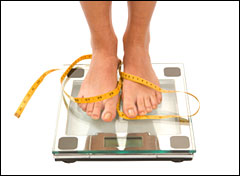Dearest Umbra,
I recently heard an interesting interview on NPR, and the speaker was talking about how, to stop global warming, all humans would have to limit their carbon emissions to just one ton of carbon per person, per year. I’ve never weighed my carbon emissions, but I’m going to guess that I throw a lot more weight around than one ton. What would I have to do to slim my ton to one? I’m approaching my carbon tonnage like a diet — I need to know how many “calories” I’m bringing in through what I consume, drive, and engage in. Is there a carbon calculator I could use? Some rule of not-so-green thumb? How do I calculate the impact of a megawatt of home heat? A five-mile drive? A 1.5-hour airline ride? A short mocha every other day? If I’m truly going to get under one ton a year, I’m going to need some way to quantify my habits. Any ideas?
Tons a Lot!
Sarah in Seattle
Dearest Sarah,
There are many carbon weight loss programs out there. One area that is ripe for study is the comparative difficulty of losing carbon weight vs. body weight. Does carbon weight loss come with the same basic problem as regular old weight loss? Is it difficult to keep the weight off once you’ve reached your goal? These questions will hopefully be what is absorbing us three years from now. In the meantime, we need to enter a phase of obsessive dieting. The typical American is responsible for 20 tons of carbon a year — we’re basically carbon obese. Whether or not one ton is the exact carbon weight allowable to each Earthling, it’s laudable to try to reduce by any significant amount.

Not low carb, low carbon!
Many tools exist that help us evaluate the emissions of our homes and our transport, using our utility bills and odometer. The short mocha is a bit harder to calculate, as we do not pay the café’s utility bill. Let’s just start today with the easier stuff and see how thin we can become on a low-math diet. Two ways to go here: You can use an online calculator, and trust its calculations; or you can get the plain old numbers from a trusted source and use your home calculator. For ease of use, I would choose the former.
The Bonneville Environmental Foundation’s calculator illustrates both of these approaches and shows a bit of what you should look for in a calculator. BEF sells personal carbon offsets; its calculator is geared toward people planning to buy said offsets, but you can use it even if you have no such intention. The format of the calculator is typical. The user follows easy instructions, typing personal data into boxes: kWh, dollars spent on heat, zip code, car mileage and miles per gallon, air travel miles, and more. Zip code is an important detail that tells the computer how your electricity is made. The computer then calculates the resultant carbon dioxide or carbon dioxide equivalent (other greenhouse gases are converted into “CO2e” in order for science to have a common workable unit), and pops out with a summation of your tonnage.
Down at the base of the BEF calculator, it says, “How Do These Calculations Work?” The pop-up window is helpful — it shows that BEF is using generally accepted numbers from the Energy Information Administration, EPA, and other federal agencies. You can see the actual mathematical calculations used, and a clear description of why certain calculations were chosen. Don’t bother using a calculator whose creators don’t explain how they make their calculations. The more detail you can get, the more you can understand how to reduce your emissions and how one calculator compares to another.
That said, I have not evaluated all the carbon calculators on the market; I’m not sure anyone has, and they’ve been proliferating like bunnies. From one perspective, any decent calculator is fine for the first phase of your diet. After all, because your emissions are certainly far more than one ton, what you are after is relative emissions loss at this point, not absolute emissions loss. It’s like the Weight Watchers suggestion: Weigh yourself once a week using the same scale every time, and even if that scale is off, you’ll know how much weight you’ve lost.
To soften that shockingly broad statement, I have a few suggestions of reputable sites that may help you be a bit more exact. The EPA’s own calculator is very basic and is certainly using solid, accepted emissions factors. It has a feature I appreciate, namely showing the emissions in each category as you go, rather than just one big number at the end. One big number is not entirely helpful for winnowing down our waists — that’s like knowing that all food contains calories, but not which foods contain the most.
If you feel more comfortable trusting the EPA calculator but wish to include a little more detail on travel emissions, you could add that data using two other sites I’ve noticed: Travel Matters calculates your transport emissions for a month-long period (easier than a year), and includes details such as carpooling, bus travel, walking, and biking. Atmosfair calculates air travel and is respected for including many small details in its calculator (length of flight, radiative forcing, etc.).
If you would like to do your own math for the whole calculation, use the emissions factors on the EPA pages. Or EPA itself links to a variety of calculators you can peruse if you would like to find one that suits you better than the few I have mentioned. Because it can be overwhelming once you start looking at lots of them, remember: Right now, you just need the basics to get started.
I hope this information will kick off an effective dieting strategy. If this first phase of the diet is too easy, we can turn to the short mocha next.
Foamily,
Umbra

